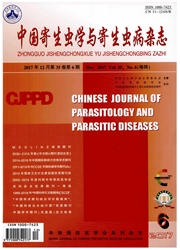

 中文摘要:
中文摘要:
目的探讨弓形虫感染对子一代雄性小鼠发育期脑部多巴胺水平的影响。方法 36只雌性ICR小鼠随机分为健康对照组和弓形虫感染组,每组18只。感染组每鼠分别经口感染弓形虫PRU弱毒株10个包囊。感染后90 d,与健康雄性ICR小鼠按1∶1交配。每组各取2只交配成功的母鼠于孕20 d时剖腹取胎鼠。其他交配成功的母鼠自然分娩。应用高效液相色谱-电化学法对孕20 d的雄性胎鼠及出生后14 d和63 d的雄性仔鼠(各6只)进行脑皮层、小脑、海马和纹状体多巴胺含量的测定。结果感染组小鼠感染后死亡3只,余15只感染鼠中,仅6只交配成功。2只于孕20 d剖腹取胎鼠12只,其中雄性7只;4只自然分娩,仔鼠存活21只,其中雄性15只。18只对照组小鼠均交配成功,2只于孕20 d时剖腹取胎鼠23只,其中雄性12只;16只自然分娩,仔鼠存活179只,其中雄性92只。感染组和对照组雄性胎鼠小脑区多巴胺含量分别为(413.25±21.78)ng/g和(346.30±51.83)ng/g,感染组显著高于对照组(P〈0.01),两者皮层区多巴胺含量差异无统计学意义(P〉0.05)。感染组出生后14 d和63 d,雄性仔鼠皮层区[(462.50±24.80)ng/g和(1 215.77±113.64)ng/g]、小脑区[(271.55±26.19)ng/g和(1 328.82±39.62)ng/g]、海马区[(225.78±24.17)ng/g和(1 322.70±58.34)ng/g]和纹状体区[(455.23±61.53)ng/g和(991.32±54.31)ng/g]的多巴胺含量均显著高于相应对照组(P〈0.05或P〈0.01)。结论弓形虫感染能引起子一代雄性小鼠发育期脑部多巴胺水平显著升高。
 英文摘要:
英文摘要:
Objective To investigate the effect of Toxoplasma gondii infection in female mice on dopamine level in the brain of male offspring. Methods Thirty-six ICR female mice were randomly divided into control group and infection group, 18 mice in each group. Each mouse in infection group was orally infected with 10 cysts of T. gondii Prugniaud strain. On the 90 th day after infection, the infected female mice were mated with normal male ICR mice at1 ∶ 1 ratio. On the 20 th day of pregnancy, 2 mice in each group were delivered for fetal mice by cesarean section, and the brain of male fetal mice(n =6) in each group were collected. On the 14 th and 63 rd day after birth, 6 male offspring mice in each group were sacrificed, and the brain were collected. Dopamine levels in the cortex, cerebellum,hippocampus, and striatum were analyzed by high-performance liquid chromatography-electrochemical detection(HPLCECD). Results Three mice in infection group died during the experiment, and 6 out of 15 female mice mated successfully. The number of fetal mice and F1 generation mice in infection group was 12(male: 7) and 21(male:15), respectively. All the mice in control group mated successfully. The number of fetal mice and F1 generation mice was 23(male: 12) and 179(male: 92), respectively. The dopamine level in the cerebellum of fetal mice of infection group and control group was(413.25 ±21.78) ng/g and(346.30 ±51.83) ng/g, respectively(P〈0.01). No significant difference was found in dopamine content in the cortex between the two groups(P〉0.05). Compared with the controlgroup, on the 14 th day and 63 rd day after birth, the dopamine content in cortical areas [(462.50±24.80) ng/g and(1 215.77 ±113.64) ng/g], cerebellum area [(271.55 ±26.19) ng/g and(1 328.82 ±39.62) ng/g ], hippocampus area[(225.78 ±24.17) ng/g and(1 322.70±58.34) ng/g], and striatum area [(455.23±61.53) ng/g and(991.32±54.31) ng/g]of the male offspring in infection group we
 同期刊论文项目
同期刊论文项目
 同项目期刊论文
同项目期刊论文
 期刊信息
期刊信息
